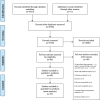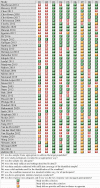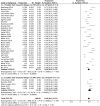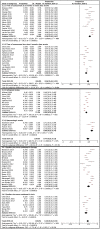Prevalence of fatigue after stroke: A systematic review and meta-analysis
- PMID: 35342803
- PMCID: PMC8948505
- DOI: 10.1177/23969873211047681
Prevalence of fatigue after stroke: A systematic review and meta-analysis
Erratum in
-
ERRATUM to Prevalence of fatigue after stroke: A systematic review and meta-analysis.Eur Stroke J. 2023 Mar;8(1):405. doi: 10.1177/23969873221133916. Epub 2022 Oct 26. Eur Stroke J. 2023. PMID: 37021159 Free PMC article.
Abstract
Background and purpose: Post-stroke fatigue is a debilitating and long-lasting condition. However, there are uncertainties regarding its prevalence and variability between studies. This review aims to estimate the prevalence of fatigue and determine the factors responsible for its variation in the literature.
Methods: A systematic review was conducted for all published studies (search to November 2020) using AMED, CINAHL, EMBASE, MEDLINE, PsycINFO, SCOPUS and Web of Science. Papers were included if they recruited participants with stroke, used a validated scale to measure fatigue and were in English. Two reviewers screened and assessed the relevant studies for eligibility (n = 96). The included papers were appraised using the Joanna Briggs Institute (JBI) tool for prevalence studies, and data were extracted by one reviewer. To understand the variation in PSF prevalence between papers, data were pooled and analysed based on relevant methodological (e.g. time of assessment) or clinical factors (e.g. depression) using Review Manager 5.4 software.
Results: While 48 studies were included and summarised (N = 9004), only 35 were appropriate for the meta-analysis (N = 6851). The most frequently used tool to measure fatigue was the Fatigue Severity Scale (FSS) (n = 31). The prevalence was calculated with a cut-off point of four or more using FSS and resulted in an estimate of 48% (95% CI 42-53%). Time of assessment (<6 vs ≥6 months), stroke type (ischaemic vs haemorrhagic/subarachnoid haemorrhage) and geographical location (East Asia vs Europe) could explain the prevalence variation between studies.
Conclusions: Fatigue is prevalent among stroke survivors. This condition varies in terms of occurrence between studies; however, time of assessment, stroke type and geographical location might explain this variation. As this review estimates the overall burden of fatigue after stroke, it provides a useful indicator to inform policy, planning and healthcare professionals. Further efforts are required to investigate the mechanisms that lead to PSF, particularly in the groups that show high prevalence, in order to prevent or alleviate it.
Keywords: fatigue; frequency; review; stroke.
© European Stroke Organisation 2021.
Conflict of interest statement
Declaration of conflicting interests: The author(s) declared no potential conflicts of interest with respect to the research, authorship, and/or publication of this article.
Figures




Similar articles
-
How has the impact of 'care pathway technologies' on service integration in stroke care been measured and what is the strength of the evidence to support their effectiveness in this respect?Int J Evid Based Healthc. 2008 Mar;6(1):78-110. doi: 10.1111/j.1744-1609.2007.00098.x. Int J Evid Based Healthc. 2008. PMID: 21631815
-
Beyond the black stump: rapid reviews of health research issues affecting regional, rural and remote Australia.Med J Aust. 2020 Dec;213 Suppl 11:S3-S32.e1. doi: 10.5694/mja2.50881. Med J Aust. 2020. PMID: 33314144
-
The Experience of Hypoglycaemia and Strategies Used For Its Management by Community-Dwelling Adults with Diabetes Mellitus: A Systematic Review.JBI Libr Syst Rev. 2011;9(50):2063-2104. doi: 10.11124/01938924-201109500-00001. JBI Libr Syst Rev. 2011. PMID: 27820436
-
Related risk factors associated with post-stroke fatigue: a systematic review and meta-analysis.Neurol Sci. 2021 Apr;42(4):1463-1471. doi: 10.1007/s10072-020-04633-w. Epub 2020 Aug 19. Neurol Sci. 2021. PMID: 32813167
-
The effect of exposure to long working hours on stroke: A systematic review and meta-analysis from the WHO/ILO Joint Estimates of the Work-related Burden of Disease and Injury.Environ Int. 2020 Sep;142:105746. doi: 10.1016/j.envint.2020.105746. Epub 2020 Jun 3. Environ Int. 2020. PMID: 32505015
Cited by
-
Study protocol of a double-blind randomized control trial of transcranial direct current stimulation in post-stroke fatigue.Front Neurol. 2024 Jan 29;14:1297429. doi: 10.3389/fneur.2023.1297429. eCollection 2023. Front Neurol. 2024. PMID: 38348114 Free PMC article.
-
Sedentary behaviour and level of physical activity among people with post COVID-19 condition: associated factors and changes over time.BMC Res Notes. 2025 Mar 20;18(1):119. doi: 10.1186/s13104-025-07177-4. BMC Res Notes. 2025. PMID: 40114283 Free PMC article.
-
Mobile health delivered physical activity after mild stroke or transient ischemic attack: Is it feasible and acceptable?Int J Stroke. 2025 Aug;20(7):801-811. doi: 10.1177/17474930251315628. Epub 2025 Jan 30. Int J Stroke. 2025. PMID: 39800974 Free PMC article. Clinical Trial.
-
The Impact of Post-stroke Depression and Physical Fatigue on Functional Status.Actas Esp Psiquiatr. 2025 Mar;53(2):315-323. doi: 10.62641/aep.v53i2.1688. Actas Esp Psiquiatr. 2025. PMID: 40071376 Free PMC article.
-
Neuroimaging of neuropsychological disturbances following ischaemic stroke (CONNECT): a prospective cohort study protocol.BMJ Open. 2024 Jan 29;14(1):e077799. doi: 10.1136/bmjopen-2023-077799. BMJ Open. 2024. PMID: 38286706 Free PMC article.
References
Publication types
LinkOut - more resources
Full Text Sources
Research Materials

